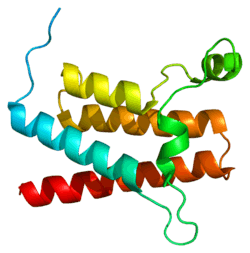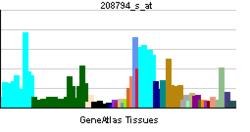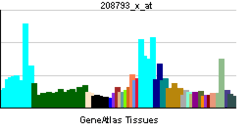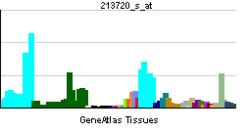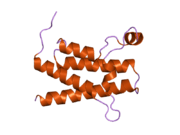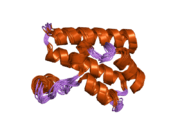SMARCA4
Transcription activator BRG1 also known as ATP-dependent helicase SMARCA4 is a protein that in humans is encoded by the SMARCA4 gene.[1]
Function
The protein encoded by this gene is a member of the SWI/SNF family of proteins and is similar to the brahma protein of Drosophila. Members of this family have helicase and ATPase activities and are thought to regulate transcription of certain genes by altering the chromatin structure around those genes. The encoded protein is part of the large ATP-dependent chromatin remodeling complex SWI/SNF, which is required for transcriptional activation of genes normally repressed by chromatin. In addition, this protein can bind BRCA1, as well as regulate the expression of the tumorigenic protein CD44.[2]
BRG1 works to activate or repress transcription. Having functional BRG1 is important for development past the pre-implantation stage. Without having a functional BRG1, exhibited with knockout research, the embryo will not hatch out of the zona pellucida, which will inhibit implantation from occurring on the endometrium (uterine wall). BRG1 is also crucial to the development of sperm. During the first stages of meiosis in spermatogenesis there are high levels of BRG1. When BRG1 is genetically damaged, meiosis is stopped in prophase 1, hindering the development of sperm and would result in infertility. More knockout research has concluded BRG1’s aid in the development of smooth muscle. In a BRG1 knockout, smooth muscle in the gastrointestinal tract lacks contractility, and intestines are incomplete in some cases. Another defect occurring in knocking out BRG1 in smooth muscle development is heart complications such as an open ductus arteriosus after birth.[3][4]
Clinical significance
Mutations in this gene were first recognized in human lung cancer cell lines.[5] Later it was recognized that mutations exist in a significant frequency of medulloblastoma and pancreatic cancers among other tumor subtypes.[6][7][8] Mutations in BRG1 (or SMARCA4) appear to be mutually exclusive with the presence of activation at any of the MYC-genes, which indicates that the BRG1 and MYC proteins are functionally related.[5][9] Another recent study demonstrated a causal role of BRG1 in the control of retinoic acid and glucocorticoid-induced cell differentiation in lung cancer and in other tumor types. This enables the cancer cell to sustain undifferentiated gene expression programs that affect the control of key cellular processes. Furthermore, it explains why lung cancer and other solid tumors are completely refractory to treatments based on these compounds that are effective therapies for some types of leukemia.[10] The role of BRG1 in sensitivity or resistance to anti-cancer drugs had been recently highlighted by the elucidation of the mechanisms of action of darinaparsin, an arsenic-based anti-cancer drugs. Darinaparsin has been shown to induce phosphorylation of BRG1, which leads to its exclusion from the chromatin. When excluded from the chromatin, BRG1 can no longer act as a transcriptional co-regulator. This leads to the inability of cells to express HO-1, a cytoprotective enzyme.[11]
Interactions
SMARCA4 has been shown to interact with:
- ACTL6A,[12][13]
- ARID1A,[12][13]
- ARID1B,[14][15]
- BRCA1,[16][17]
- CTNNB1,[18]
- CBX5,[19]
- CREBBP,[20][21]
- CCNE1,[22][23]
- ESR1,[20][24]
- FANCA,[25][26]
- HSP90B1,[25]
- ING1,[27]
- Myc,[28][29]
- NR3C1,[30][31]
- P53,[32]
- POLR2A,[12][13][33]
- PHB,[34]
- SIN3A,[27][33]
- SMARCB1,[12][13][25][33][35]
- SMARCC1,[12][13][25][33]
- SMARCC2,[12][13][25]
- SMARCE1,[12][13]
- STAT2,[36] and
- STK11.[37]
References
- ↑ Chiba H, Muramatsu M, Nomoto A, Kato H (July 1994). "Two human homologues of Saccharomyces cerevisiae SWI2/SNF2 and Drosophila brahma are transcriptional coactivators cooperating with the estrogen receptor and the retinoic acid receptor". Nucleic Acids Res 22 (10): 1815–20. doi:10.1093/nar/22.10.1815. PMC 308079. PMID 8208605.
- ↑ "Entrez Gene: SMARCA4 SWI/SNF related, matrix associated, actin dependent regulator of chromatin, subfamily a, member 4".
- ↑ Kim Y, Fedoriw AM, Magnuson T (March 2012). "An essential role for a mammalian SWI/SNF chromatin-remodeling complex during male meiosis". Development 139 (6): 1133–40. doi:10.1242/dev.073478. PMC 3283123. PMID 22318225.
- ↑ Zhang M, Chen M, Kim JR, Zhou J, Jones RE, Tune JD, Kassab GS, Metzger D, Ahlfeld S, Conway SJ, Herring BP (July 2011). "SWI/SNF complexes containing Brahma or Brahma-related gene 1 play distinct roles in smooth muscle development". Mol. Cell. Biol. 31 (13): 2618–31. doi:10.1128/MCB.01338-10. PMC 3133369. PMID 21518954.
- ↑ 5.0 5.1 Medina PP, Romero OA, Kohno T, Montuenga LM, Pio R, Yokota J, Sanchez-Cespedes M (May 2008). "Frequent BRG1/SMARCA4-inactivating mutations in human lung cancer cell lines". Hum. Mutat. 29 (5): 617–22. doi:10.1002/humu.20730. PMID 18386774.
- ↑ Jones DT, Jäger N, Kool M, Zichner T, Hutter B, Sultan M, Cho YJ, Pugh TJ, Hovestadt V, Stütz AM et al. (2012). "Dissecting the genomic complexity underlying medulloblastoma". Nature 488 (7409): 100–5. doi:10.1038/nature11284. PMC 3662966. PMID 22832583.
- ↑ Shain AH, Giacomini CP, Matsukuma K, Karikari CA, Bashyam MD, Hidalgo M, Maitra A, Pollack JR (2012). "Convergent structural alterations define SWItch/Sucrose NonFermentable (SWI/SNF) chromatin remodeler as a central tumor suppressive complex in pancreatic cancer". Proc. Natl. Acad. Sci. U.S.A. 109 (5): E252–9. doi:10.1073/pnas.1114817109. PMC 3277150. PMID 22233809.
- ↑ Shain AH, Pollack JR (2013). "The spectrum of SWI/SNF mutations, ubiquitous in human cancers". PLoS ONE 8 (1): e55119. doi:10.1371/journal.pone.0055119. PMC 3552954. PMID 23355908.
- ↑ Romero OA, Sanchez-Cespedes M. (Jun 2013). "The SWI/SNF genetic blockade: effects in cell differentiation, cancer and developmental diseases". Oncogene. Epub ahead of print. doi:10.1038/onc.2013.227. PMID 23752187.
- ↑ Romero OA, Setien F, John S, Gimenez-Xavier P, Gómez-López G, Pisano D, Condom E, Villanueva A, Hager GL, Sanchez-Cespedes M (Jul 2012). "The tumour suppressor and chromatin-remodelling factor BRG1 antagonizes Myc activity and promotes cell differentiation in human cancer.". EMBO Mol. Med. 4 (7): 603–16. doi:10.1002/emmm.201200236. PMID 22407764.
- ↑ Garnier N, Petruccelli LA, Molina MF, Kourelis M, Kwan S, Diaz Z, Schipper HM, Gupta A, del Rincon SV, Mann KK, Miller WH (2013). "The novel arsenical Darinaparsin circumvents BRG1-dependent, HO-1-mediated cytoprotection in leukemic cells". Leukemia 27 (11): 2220–8. doi:10.1038/leu.2013.54. PMID 23426167.
- ↑ 12.0 12.1 12.2 12.3 12.4 12.5 12.6 Wang W, Côté J, Xue Y, Zhou S, Khavari PA, Biggar SR, Muchardt C, Kalpana GV, Goff SP, Yaniv M, Workman JL, Crabtree GR (1996). "Purification and biochemical heterogeneity of the mammalian SWI-SNF complex". EMBO J. 15 (19): 5370–82. PMC 452280. PMID 8895581.
- ↑ 13.0 13.1 13.2 13.3 13.4 13.5 13.6 Zhao K, Wang W, Rando OJ, Xue Y, Swiderek K, Kuo A, Crabtree GR (1998). "Rapid and phosphoinositol-dependent binding of the SWI/SNF-like BAF complex to chromatin after T lymphocyte receptor signaling". Cell 95 (5): 625–36. doi:10.1016/S0092-8674(00)81633-5. PMID 9845365.
- ↑ Hurlstone AF, Olave IA, Barker N, van Noort M, Clevers H (2002). "Cloning and characterization of hELD/OSA1, a novel BRG1 interacting protein". Biochem. J. 364 (Pt 1): 255–64. PMC 1222568. PMID 11988099.
- ↑ Inoue H, Furukawa T, Giannakopoulos S, Zhou S, King DS, Tanese N (2002). "Largest subunits of the human SWI/SNF chromatin-remodeling complex promote transcriptional activation by steroid hormone receptors". J. Biol. Chem. 277 (44): 41674–85. doi:10.1074/jbc.M205961200. PMID 12200431.
- ↑ Hill DA, de la Serna IL, Veal TM, Imbalzano AN (2004). "BRCA1 interacts with dominant negative SWI/SNF enzymes without affecting homologous recombination or radiation-induced gene activation of p21 or Mdm2". J. Cell. Biochem. 91 (5): 987–98. doi:10.1002/jcb.20003. PMID 15034933.
- ↑ Bochar DA, Wang L, Beniya H, Kinev A, Xue Y, Lane WS, Wang W, Kashanchi F, Shiekhattar R (2000). "BRCA1 is associated with a human SWI/SNF-related complex: linking chromatin remodeling to breast cancer". Cell 102 (2): 257–65. doi:10.1016/S0092-8674(00)00030-1. PMID 10943845.
- ↑ Barker N, Hurlstone A, Musisi H, Miles A, Bienz M, Clevers H (2001). "The chromatin remodelling factor Brg-1 interacts with beta-catenin to promote target gene activation". EMBO J. 20 (17): 4935–43. doi:10.1093/emboj/20.17.4935. PMC 125268. PMID 11532957.
- ↑ Nielsen AL, Sanchez C, Ichinose H, Cerviño M, Lerouge T, Chambon P, Losson R (2002). "Selective interaction between the chromatin-remodeling factor BRG1 and the heterochromatin-associated protein HP1alpha". EMBO J. 21 (21): 5797–806. doi:10.1093/emboj/cdf560. PMC 131057. PMID 12411497.
- ↑ 20.0 20.1 DiRenzo J, Shang Y, Phelan M, Sif S, Myers M, Kingston R, Brown M (2000). "BRG-1 is recruited to estrogen-responsive promoters and cooperates with factors involved in histone acetylation". Mol. Cell. Biol. 20 (20): 7541–9. doi:10.1128/MCB.20.20.7541-7549.2000. PMC 86306. PMID 11003650.
- ↑ Neish AS, Anderson SF, Schlegel BP, Wei W, Parvin JD (1998). "Factors associated with the mammalian RNA polymerase II holoenzyme". Nucleic Acids Res. 26 (3): 847–53. doi:10.1093/nar/26.3.847. PMC 147327. PMID 9443979.
- ↑ Wong AK, Shanahan F, Chen Y, Lian L, Ha P, Hendricks K, Ghaffari S, Iliev D, Penn B, Woodland AM, Smith R, Salada G, Carillo A, Laity K, Gupte J, Swedlund B, Tavtigian SV, Teng DH, Lees E (2000). "BRG1, a component of the SWI-SNF complex, is mutated in multiple human tumor cell lines". Cancer Res. 60 (21): 6171–7. PMID 11085541.
- ↑ Shanahan F, Seghezzi W, Parry D, Mahony D, Lees E (1999). "Cyclin E associates with BAF155 and BRG1, components of the mammalian SWI-SNF complex, and alters the ability of BRG1 to induce growth arrest". Mol. Cell. Biol. 19 (2): 1460–9. PMC 116074. PMID 9891079.
- ↑ Ichinose H, Garnier JM, Chambon P, Losson R (1997). "Ligand-dependent interaction between the estrogen receptor and the human homologues of SWI2/SNF2". Gene 188 (1): 95–100. doi:10.1016/S0378-1119(96)00785-8. PMID 9099865.
- ↑ 25.0 25.1 25.2 25.3 25.4 Otsuki T, Furukawa Y, Ikeda K, Endo H, Yamashita T, Shinohara A, Iwamatsu A, Ozawa K, Liu JM (2001). "Fanconi anemia protein, FANCA, associates with BRG1, a component of the human SWI/SNF complex". Hum. Mol. Genet. 10 (23): 2651–60. doi:10.1093/hmg/10.23.2651. PMID 11726552.
- ↑ Reuter TY, Medhurst AL, Waisfisz Q, Zhi Y, Herterich S, Hoehn H, Gross HJ, Joenje H, Hoatlin ME, Mathew CG, Huber PA (2003). "Yeast two-hybrid screens imply involvement of Fanconi anemia proteins in transcription regulation, cell signaling, oxidative metabolism, and cellular transport". Exp. Cell Res. 289 (2): 211–21. doi:10.1016/S0014-4827(03)00261-1. PMID 14499622.
- ↑ 27.0 27.1 Kuzmichev A, Zhang Y, Erdjument-Bromage H, Tempst P, Reinberg D (2002). "Role of the Sin3-histone deacetylase complex in growth regulation by the candidate tumor suppressor p33(ING1)". Mol. Cell. Biol. 22 (3): 835–48. doi:10.1128/MCB.22.3.835-848.2002. PMC 133546. PMID 11784859.
- ↑ Ewing RM, Chu P, Elisma F, Li H, Taylor P, Climie S, McBroom-Cerajewski L, Robinson MD, O'Connor L, Li M, Taylor R, Dharsee M, Ho Y, Heilbut A, Moore L, Zhang S, Ornatsky O, Bukhman YV, Ethier M, Sheng Y, Vasilescu J, Abu-Farha M, Lambert JP, Duewel HS, Stewart II, Kuehl B, Hogue K, Colwill K, Gladwish K, Muskat B, Kinach R, Adams SL, Moran MF, Morin GB, Topaloglou T, Figeys D (2007). "Large-scale mapping of human protein-protein interactions by mass spectrometry". Mol. Syst. Biol. 3 (1): 89. doi:10.1038/msb4100134. PMC 1847948. PMID 17353931.
- ↑ Park J, Wood MA, Cole MD (2002). "BAF53 forms distinct nuclear complexes and functions as a critical c-Myc-interacting nuclear cofactor for oncogenic transformation". Mol. Cell. Biol. 22 (5): 1307–16. doi:10.1128/MCB.22.5.1307-1316.2002. PMC 134713. PMID 11839798.
- ↑ Hsiao PW, Fryer CJ, Trotter KW, Wang W, Archer TK (2003). "BAF60a mediates critical interactions between nuclear receptors and the BRG1 chromatin-remodeling complex for transactivation". Mol. Cell. Biol. 23 (17): 6210–20. doi:10.1128/MCB.23.17.6210-6220.2003. PMC 180928. PMID 12917342.
- ↑ Wallberg AE, Neely KE, Hassan AH, Gustafsson JA, Workman JL, Wright AP (2000). "Recruitment of the SWI-SNF chromatin remodeling complex as a mechanism of gene activation by the glucocorticoid receptor tau1 activation domain". Mol. Cell. Biol. 20 (6): 2004–13. doi:10.1128/MCB.20.6.2004-2013.2000. PMC 110817. PMID 10688647.
- ↑ Lee D, Kim JW, Seo T, Hwang SG, Choi EJ, Choe J (2002). "SWI/SNF complex interacts with tumor suppressor p53 and is necessary for the activation of p53-mediated transcription". J. Biol. Chem. 277 (25): 22330–7. doi:10.1074/jbc.M111987200. PMID 11950834.
- ↑ 33.0 33.1 33.2 33.3 Sif S, Saurin AJ, Imbalzano AN, Kingston RE (2001). "Purification and characterization of mSin3A-containing Brg1 and hBrm chromatin remodeling complexes". Genes Dev. 15 (5): 603–18. doi:10.1101/gad.872801. PMC 312641. PMID 11238380.
- ↑ Wang S, Zhang B, Faller DV (2002). "Prohibitin requires Brg-1 and Brm for the repression of E2F and cell growth". EMBO J. 21 (12): 3019–28. doi:10.1093/emboj/cdf302. PMC 126057. PMID 12065415.
- ↑ Sullivan EK, Weirich CS, Guyon JR, Sif S, Kingston RE (2001). "Transcriptional activation domains of human heat shock factor 1 recruit human SWI/SNF". Mol. Cell. Biol. 21 (17): 5826–37. doi:10.1128/MCB.21.17.5826-5837.2001. PMC 87302. PMID 11486022.
- ↑ Huang M, Qian F, Hu Y, Ang C, Li Z, Wen Z (2002). "Chromatin-remodelling factor BRG1 selectively activates a subset of interferon-alpha-inducible genes". Nat. Cell Biol. 4 (10): 774–81. doi:10.1038/ncb855. PMID 12244326.
- ↑ Marignani PA, Kanai F, Carpenter CL (2001). "LKB1 associates with Brg1 and is necessary for Brg1-induced growth arrest". J. Biol. Chem. 276 (35): 32415–8. doi:10.1074/jbc.C100207200. PMID 11445556.
Further reading
- Medina PP, Sanchez-Cespedes M, Cespedes MS (2008). "Involvement of the chromatin-remodeling factor BRG1/SMARCA4 in human cancer". Epigenetics 3 (2): 64–8. doi:10.4161/epi.3.2.6153. PMID 18437052.
- Voellmy R (1996). "Sensing stress and responding to stress.". EXS 77: 121–37. doi:10.1007/978-3-0348-9088-5_9. PMID 8856972.
- Peterson CL (2002). "Chromatin remodeling: nucleosomes bulging at the seams.". Curr. Biol. 12 (7): R245–7. doi:10.1016/S0960-9822(02)00782-0. PMID 11937040.
External links
| |||||||||||
